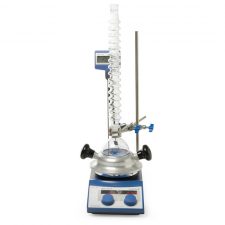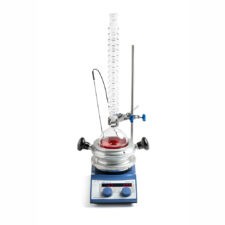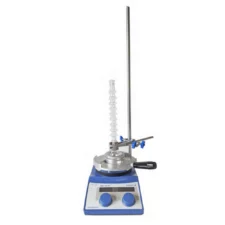CondenSyn® Evaluation:
What type of laboratory is the product used in: Drug discovery laboratory
What key work is undertaken in your laboratory and how does the product help?: I had previous experience using CondenSyn® at Caltech and advocated for their purchase and use here because the current set up was recirculating water (while that already generates less waste and saves money compared to just using water and emptying into a drain, there were other drawbacks/issues).
What did you use before the CondenSyn?: water condensers using recirculating, cooled water.
What were the issues you had before choosing to purchase the CondenSyn?: Variable water pressure or failed water supply, leading to either stop of water flow or over pressurizing, causing tubing to pop off and hood flooding (the recirculating water does have a sensor to stop when it detects the pressure to drop when tubing pops off. Either way though, it causes a mess and the reaction will no longer be cooled by the condenser, which is a safety concern. Sometimes that sensor also did not kick in, causing flooding of the fume hood. The other concern with fluctuating or unreliable water flow is that the reaction solvent escapes, and that is also of many chemist’ concern (drying out of their reaction).
Have you ever used any other type of waterless condenser?: No, only CondenSyn. We did have a demonstration of an alternative in lab, but my past experience with CondenSyn made me lean in that direction. Also, chemists felt strongly that they did not like that you cannot see inside this alternative condenser (it is jacketed with aluminium) and that you cannot put it into an oven to dry it to remove any residual water. The alternative condenser is supposedly only rated for lower oven temperatures, whereas common laboratory oven to dry glassware is ca. 120 oC. Since I had previous experience with the CondenSyn, and knew you can put it in the oven, it was a no-brainer.
Now that you’ve had the CondenSyn in use for 6 months +, what do you find to be the biggest benefit?: No need to worry about the condenser – water tubing connections > eg. reaction setup is so much neater, without a lot of tubing everywhere. no need to disconnect water tubing and having that spill around. overall also less clutter in the fume hood without tubing etc.
Above all, avoids all of the fume hood flood issues we had previously and we can now leave reactions refluxing overnight worry-free.
What solvents do you use the CondenSyn to reflux?:
- Carbon tetrachloride
- THF
- 2-propanol
- Dichloromethane
- 1,2-dichloroethane
- DMF
- Acetonitrile
- thionyl chloride/acetronitrile
- Ethanol
- Diels-Alder reaction with Furan (fairly volatile, ~ 31 oC) and acetronitrile (1:1 ratio). The reaction proceeded well and no loss of furan was observed (20 mL volume in 350 mm CondenSyn).
What volume of solvents are you refluxing? What size CondenSyn are you using?: Largely using the 350 mm CondenSyn with up to 500 mL round bottom flask. Most of our solvent volumes are below 200 mL. Feedback obtained at the following volumes: 10 / 15 / 20 / 40 / 70 / 140 mL.
How many condensers do you have in your lab?: 20x 350 mm and 2x 450 mm
What do you think of the size of the CondenSyn?: Chemists have noted that the 350 mm CondenSyn is tall (taller than they are used to) however, the ease of setup is really so fantastic (without the need for tubing and copper wire/zip tie etc) that the height is not really of any concern. We just recommend clamping the top of the condenser.
How robust do you find the CondenSyn?: Very robust so far!
Do you ever clean your CondenSyn and, if so, how easy do you find it to do so?: Yes, after each reaction they are rinsed. Cleaning so far has been easy, as we have not had any splashes or chemicals bump up. So usually acetone/water/acetone does the trick. my personal experience is that if anything is on the joint, one can use 1M HCI and add that to a paper towel, wipe off the ground glass joint, then rinse with water, followed by acetone. Some chemists commented that if they obtained a lot of residue inside the condenser that they would plan to place in a solvent bath overnight however we have not yet needed to do so.
Have you seen any water saving costs by using the CondenSyn?: Unfortunately, I do not have this data. Especially since we used recirculating water, the use of CondenSyn for us is more about peace of mind when leaving reactions overnight because we do not want any floods in our fume hood due to the recirculating water and any possible water pressure changes.
Would you recommend CondenSyn to other people?: Certainly, and I have already done so (from Caltech, now to here).
Any other comments/notes: I recommend using PTFE rings to ensure a really nice tight seal because some manufacturer’s glassware don’t always perfectly fit.
PhD Medicinal Chemist, Pharmaceutical Company, USA
Reference: ASY-EV-157







